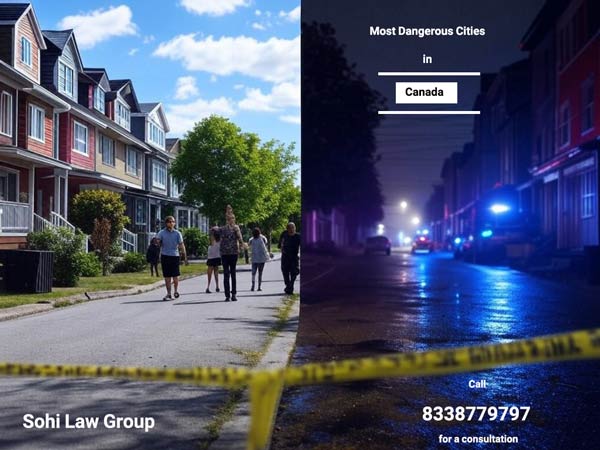Table of Contents
Canada’s Most Dangerous Cities in 2025: What Immigrants Need to Know
While Canada is renowned for its safe and welcoming communities, certain cities face higher crime challenges. For 2025, updated Crime Index data highlights the country’s most dangerous cities, offering valuable insights for immigrants and residents alike. This information is essential for making informed decisions about settlement, employment, and personal safety.
The rankings are based on the Crime Severity Index (CSI), which evaluates the volume and severity of crimes, including violent offenses, property crimes, and substance misuse. Notable cities on the 2025 list include Lethbridge, Alberta (drug-related crimes and urbanization issues), Winnipeg, Manitoba (violent crimes tied to socioeconomic struggles), and Surrey, British Columbia (gang activity and drug offenses). Smaller cities like Thompson, Manitoba, and Vernon, British Columbia, also appear due to high rates of assault and property crimes.
For immigrants, understanding city-specific safety concerns is critical. While high crime rates are often concentrated in specific neighborhoods, cities like Edmonton and Kelowna still offer significant opportunities with the right precautions. Immigration legal experts, such as Sohi Law Group, advise newcomers to consult resources, assess risks, and prioritize community safety when planning their settlements.
Ultimately, awareness and preparation enable immigrants to navigate Canada’s challenges and thrive, even in cities with higher crime levels. With tailored guidance, it’s possible to build a safe and sustainable future in the Great White North.
Understanding the Most Dangerous Cities in Canada for 2025 According to Crime Index Data
Canada is often recognized for its peaceful cities and safe communities, yet there remain regions where crime poses a higher risk to residents. Understanding the crime patterns and safety levels in various cities is vital for individuals considering relocating to Canada or immigrants planning their settlement. The latest Crime Index data for 2025 provides updated insight into the cities with the highest crime rates in Canada. This data is not just important for safety precautions but also for making informed decisions about where to live or work when emigrating to the country.
For newcomers, addressing such realities with proper planning and consultation is crucial. At Sohi Law Group, we often assist skilled workers, permanent residents, and entrepreneurs in navigating such decisions. Below, we delve into the ten Canadian cities that currently rank as the most dangerous for 2025, offering an analysis to assist both current residents and aspiring immigrants.

What Determines a Most Dangerous City?
The ranking of Canada’s most dangerous cities is generally based on a Crime Severity Index (CSI), which assesses not only the volume of crime but its severity. Factors considered include violent crimes, property crimes, and cases of substance misuse, among others. The national CSI average provides a benchmark, allowing specific cities to be evaluated as either above or below this average.
This year’s analysis highlights the evolving nature of criminal activity across Canada. While the causes of high crime rates range from economic pressures to drug-related concerns, understanding these nuances is key for anyone interested in settling within or even traveling to these regions.
Cities with High Crime Severity in 2025
As of 2025’s data update, the following cities rank highest on the danger scale:
1. Lethbridge, Alberta:
The city maintains a high Crime Severity Index largely due to drug-related offenses and property crimes. Rapid urbanization and social issues contribute to its position on the list.
2. Kelowna, British Columbia:
While known for its natural beauty, Kelowna’s growing population has seen an increase in violent crime and drug offenses. It remains a popular city but with an important caveat—local safety concerns.
3. Winnipeg, Manitoba:
Manitoba’s largest city has consistently struggled with violent crimes and theft, often influenced by socioeconomic struggles in certain areas.
4. Thompson, Manitoba:
A smaller city but one with disproportionately high crime rates, including substance abuse-related offenses and assaults.
5. Regina, Saskatchewan:
Regina consistently ranks as one of Saskatchewan’s most crime-affected areas, particularly in terms of violent attacks and theft.
6. Vernon, British Columbia:
Similar to Kelowna, Vernon grapples with property crimes and drug-related issues despite its reputation as a family-friendly destination.
7. Prince Albert, Saskatchewan:
With growing concerns related to gang-related violence and substance trafficking, Prince Albert’s challenges highlight the dynamics of small-city criminal activity.
8. Sudbury, Ontario:
While Sudbury’s crime rates fluctuate, property-related crime and vandalism remain concerning for residents and newcomers.
9. Edmonton, Alberta: As Alberta’s capital, Edmonton has pockets with rising violent crime and drug problems, though efforts at community policing continue to gain traction.
10. Surrey, British Columbia:
Although known for its cultural diversity and economic opportunities, Surrey faces ongoing struggles with drug activity, gang-related crimes, and property violations.
Interpreting These Findings as a Newcomer or Resident
Immigrants often settle in new cities based on employment opportunities, family connections, or community support resources. Understanding crime rates in Canadian cities helps newcomers make informed choices about where to reside. However, it’s important to remember that high crime rates are typically clustered in specific neighborhoods rather than city-wide.
Certain cities on the list, like Edmonton and Winnipeg, may offer immense opportunities but require an understanding of neighborhood-specific safety conditions. Consulting local law enforcement recommendations and reviewing community resources can help residents mitigate risks.
The Legal Perspective: Safety and Immigration Advice
From a legal standpoint, safety remains intertwined with immigration settlement strategies. Whether you are pursuing permanent residency, a work permit, or studying in Canada, your choices about where to live significantly impact your settlement success. At Sohi Law Group, we understand these complexities and provide tailored assistance in evaluating settlement options, work opportunities, and community safety insights.
Past clients who relocated to cities like Regina or Surrey have benefited from pre-arrival consultations that assessed safety conditions and helped connect families to reliable housing opportunities outside higher-risk areas. Our goal is not merely to assist you in gaining admission to Canada but also in creating a sustainable lifestyle post-immigration.

Takeaways for Immigrants
While these rankings offer insight into areas with higher crime severity in 2025, the underlying factors shaping these trends are multifaceted. Cities, large or small, experience cycles of change influenced by economics, population growth, and law enforcement efforts. Awareness and proactive planning remain the keys to thriving in Canada, even in cities with perceived risks.
If you are preparing to immigrate to Canada or considering relocating to one of the more challenging metropolitan areas, Sohi Law Group is here to guide you through your settlement process with expert recommendations and practical safety advice. Whether you’re a victim or wrongly accused, harassment is a crime Sohi Law Group helps you navigate with clarity and support. Understanding your new environment is a fundamental step in building a successful and safe future, and we are dedicated to making that transition seamless for you.





No comment